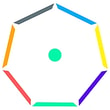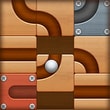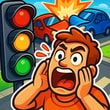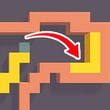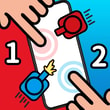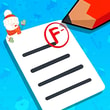🏝️ Footprints in the Sand, Numbers on the Breeze
The tide pulls back and leaves a clean grid of sand, each row and column whispering a number. That’s your brief. In Island Puzzle: Build & Solve you aren’t rushing; you’re reading. Tap a tile and a tiny house appears like it always meant to be there. Tap the wrong spot and the coastline frowns. Every row count tells you how many buildings remain in that line; every column does the same. Logic is the compass, deduction is the boat, and your finger is the boom that swings at the perfect moment. Calm? Yes. Easy? Not when the island gets opinionated.
🧭 The Grammar of a Good Guess (which isn’t a guess at all)
Each clue counts down from possible to inevitable. A “0” on a column is a gift—no buildings here, mark it mentally and keep moving. A “5” on a row in a five-wide grid? That’s destiny; fill the lot and watch the counters snap into fresh truths. Most turns live in the almosts: a line needs two, but three empty spots remain; another line needs one, but you can see which cell connects two neighborhoods neatly. You’ll chain little certainties into bigger ones until an entire corner of the map feels inevitable, like a tide you predicted twelve moves ago.
🏗️ Building Without Brute Force
Placing a structure is easy; placing it properly is art. You’ll learn to anchor from extremes, to fill from islands of certainty outward, to use zeros as fences and full counts as bridges. The temptation is to pepper houses wherever the mood strikes. Resist. Imagine the skyline before you commit. Ask yourself which placement gives the next-best deduction rather than the prettiest view right now. Good puzzling always plays one move ahead, like setting a hammock between two palm trees you haven’t planted yet but absolutely will.
🌊 The Rhythm of Reveal and Restraint
A great board hums between action and pause. Two taps flood a shoreline with certainty; then you stop, squint, and let the clues breathe. That little beat—this half second of “hmm”—is where your instincts sharpen. In early levels you’ll surf a wave of obvious fills, smiling as counters tick down like friendly odometers. Later, the grid gets chatty in riddles: “four left across, but your last column only has room for two—so try the elbow near the cove.” When it clicks, the island feels like a partner, not an opponent.
🏞️ Maps That Feel Like Places
This is a logic game, yes, but the art direction helps your brain inhabit the board. Coastlines curve across your imagination as you complete neighborhoods. A central plaza emerges when you settle the middle row. A lighthouse, purely cosmetic but emotionally persuasive, appears when you finish a column that took forever. None of these change the rules, yet somehow they make decisions clearer: place here and the street reads; place there and the beach breathes. Suddenly your tidy deductions are also urban planning, and it rules.
🧠 Little Tricks from Future You
Mark negatives in your mind. When a row says “2” and you’ve already placed two, treat the rest as seashells—untouchable, safe to ignore. When the counts are tight, test a hypothetical in your head: if I place here, can the column still reach its target without overlap? If not, that cell is forbidden. Another favorite: even-odd parity checks. If a row needs three and only three alternate spaces remain, the pattern is locked. Snap them in and let the counters cascade. You’ll start hearing a quiet metronome: consider, commit, confirm, continue.
⏳ Cozy, Not Sleepy
The loop is relaxing without being dull. You’re not punished for thinking. There’s no timer chewing your ear unless you opt into the spicy modes later. The difficulty climbs like a gentle hike: early grids are breezy beachfronts, midgame boards thread canals and courtyards, and endgame islands sprawl wider with rows that tease you into planning whole neighborhoods before you dare touch a tile. It’s the good kind of quiet—brain-scratching, shoulder-dropping, one-more-puzzle-before-bed quiet.
🔎 Tap, Look, Learn—Controls That Disappear
On mobile, you tap the ground to place a building and the feedback is immediate: a soft plunk, a cheerful puff of dust, counters nudge down with tiny ticks you’ll grow to love. On desktop, a click lands precisely, the cursor glides like a tide line, and undo is a gentle rewind rather than a scold. The interface stays small and polite: counts hug the grid edges, hints remain optional, and a subtle highlight keeps your eyes on the current row and column so you never need to squint at math when you’re in the groove.
🎯 Hints That Teach, Not Spoil
Stuck? A nudge doesn’t solve for you; it points where logic already whispers. “Consider this row,” it suggests, or “check the intersection here,” and suddenly you see why the answer was yours all along. The best hint system is a teacher that leaves, and this one leaves fast. Turn it off once you catch the scent; turn it on if the day was long and you just want to glide. Either way, your pride stays intact.
🏆 Modes, Medals, and Micro-Goals
Classic mode is “fill the island and enjoy the view.” Challenge mode sprinkles constraints: finish without mistakes, complete four corners before the center, solve with fewer placements than par. Daily islands arrive like bottled messages—bite-size, flavorful, and gone tomorrow. Streaks earn modest medals that glint just enough to make you grin when they pop. Global leaderboards exist, but they’re the kind you glance at between sips of tea rather than the kind you carve into stone.
🎵 Sound of a Thought Landing
Every correct placement chimes softly. Each finished row answers with a friendly thunk, like a boardwalk plank stepping into place. Ambient surf hushes in the background; gulls call when you clear a tricky section; a tiny marimba flourish greets a perfect board. Wear headphones and the puzzle becomes a soundscape: not dramatic, but precise, syncing little victories to little notes until your brain equates deduction with melody.
🧩 Why It’s Sneaky-Good for Your Brain
Numbers in rows and columns exercise working memory and spatial deduction—skills that feel suspiciously like superpowers everywhere else. After a few boards you’ll notice patterns earlier, doubt less, and recover faster from dead ends. You’ll also pick up patience as a habit. There’s no adrenaline tax here; there’s just the steady satisfaction of turning uncertainty into a tidy shoreline one tile at a time.
🌐 Five Minutes or Fifty—Kiz10 Makes It Fit
Open, tap a handful of tiles, close the tab with a small, smug smile. Or settle in and clear a whole archipelago while your tea cools into contemplation. Loads are quick, inputs are crisp, and restarts are instant if you decide to replay for a cleaner solution path. Kiz10 gives puzzle games what they deserve: a frictionless table, a comfy chair, and a button that says “again” without judgment.
🏁 The Moment You’ll Remember
You stare at a stubborn center row that needs three, then notice the left column is already at its limit. That means the corner can’t be a house, which forces the middle pair to be, which fills the row, which drops the column count to zero, which flips two more cells to sea, which completes a plaza you didn’t know you were building until it smiled back. The board exhales. The island gleams. You didn’t guess. You listened. And that, more than the fireworks, is why Island Puzzle: Build & Solve sticks.
 Amazing Grabber
Amazing Grabber



